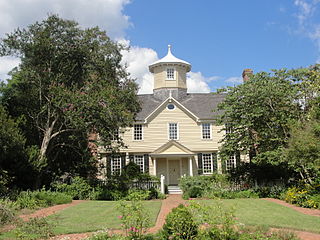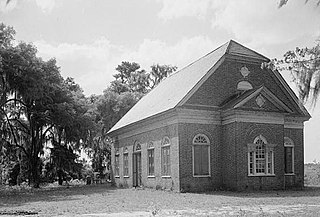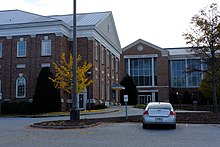
Robert Mills was a South Carolina architect and cartographer known for designing both the first Washington Monument, located in Baltimore, Maryland, as well as the better known monument to the first president in the nation's capital, Washington, DC. He is sometimes said to be the first native-born American to be professionally trained as an architect. Charles Bulfinch of Boston perhaps has a clearer claim to this honor.

The Kingstree Historic District contains forty-eight properties situated along Main Street, Academy Street, and Hampton Street in the commercial area of downtown Kingstree, South Carolina. The district includes the courthouse, public library, railroad station, and numerous commercial buildings. The district is a fine collection of nineteenth-century vernacular commercial architecture. Details such as arched doorways and windows, cast-iron columns and pilasters, decorative or corbelled brickwork and pressed tin interior ceilings are present on most of the district's buildings. The Williamsburg County Courthouse, built ca. 1823, and designed by Robert Mills, is a fine example of Roman neoclassical design with its raised first floor, pediment with lunette, and Doric columns. In 1953-54 the courthouse underwent substantial remodeling on the exterior and interior, though it still reflects much of Mill's original design. With the exception of the courthouse, most of the buildings in the district were built between 1900 and 1920 when Kingstree enjoyed prosperity as a retail and tobacco marketing center of Williamsburg County. The majority of the buildings in the district are a visible record of this twenty-year growth and the historic fabric of the area remains substantially intact. The Kingstree Historic District was listed in the National Register of Historic Places June 28, 1982.

Samuel Sloan was a Philadelphia-based architect and best-selling author of architecture books in the mid-19th century. He specialized in Italianate villas and country houses, churches, and institutional buildings. His most famous building—the octagonal mansion "Longwood" in Natchez, Mississippi—is unfinished; construction was abandoned during the American Civil War.

The William Gibbes House is a historic house at 64 South Battery in Charleston, South Carolina. Built about 1772, it is one of the nation's finest examples of classical Georgian architecture. It was declared a National Historic Landmark in 1970.

The Fireproof Building, also known as the County Records Building, is located at 100 Meeting Street, at the northwest corner of Washington Square, in Charleston, South Carolina. Completed in 1827, it was the most fire-resistant building in America at the time, and is believed to be the oldest fire-resistant building in America today.

The William Aiken House and Associated Railroad Structures make up a National Historic Landmark District in Charleston, South Carolina, that contains structures of South Carolina Canal and Railroad Company and the home of the company's founder, William Aiken. These structures make up one of the largest collection of surviving pre-Civil War railroad depot facilities in the United States. The district was declared a National Historic Landmark in 1963.

Bethesda Presbyterian Church is a historic church at 502 DeKalb Street in Camden, South Carolina. A National Historic Landmark, the main church building was built in 1822 and is one of few surviving churches designed by 19th-century American architect Robert Mills.

The Chowan County Courthouse is a historic courthouse in Edenton, the county seat of Chowan County, North Carolina. Built in 1767, it is one of the finest examples of public Georgian architecture in the American South. It was declared a National Historic Landmark in 1970.

The Cupola House is a historic house museum in Edenton, North Carolina. Built in 1756–1758, it is the second oldest building in Edenton, and the only known surviving example in the American South of a "jutt," or overhanging second floor. It was declared a National Historic Landmark in 1970.

The Lancaster County Jail is a historic former jail building at 208 West Gay Street. Built in 1823, it is a virtually unaltered work of the noted early American architect Robert Mills, and reflects innovative changes in jail design promoted by him. It is individually listed on the National Register of Historic Places, and was declared a National Historic Landmark in 1973.

The Graniteville Historic District encompasses one of the first textile company towns to be established in the Southern United States. Built in the late 1840s by William Gregg near Aiken, South Carolina, and now known as Graniteville, it was modeled after New England mill towns. Gregg used the success of this enterprise to advocate for the industrialization of the South, laying the groundwork for its eventual domination of the American textile industry. The district, which includes the original canal, mill building, mill worker housing, and a period church, was designated a National Historic Landmark District in 1978.

Woodlands, or the William Gilmore Simms Estate, is a historic plantation estate in Bamberg County, South Carolina. The property is nationally notable as the home for many years of author William Gilmore Simms (1806-1870), considered one of the leading literary voices of the antebellum Southern United States, and was designated a National Historic Landmark in 1971. The main house, built in part by Simms, contains mementos from his period.

PompionHill Chapel is small "back parish" church near Huger, South Carolina. Built in 1763, it is a virtually unaltered example of a brick Georgian parish church, retaining interior and exterior finishes. It was declared a National Historic Landmark in 1970.
William Augustus Edwards, also known as William A. Edwards was an Atlanta-based American architect renowned for the educational buildings, courthouses and other public and private buildings that he designed in Florida, Georgia and his native South Carolina. More than 25 of his works have been listed on the National Register of Historic Places.

The Old Greene County Courthouse is a historic courthouse in Eutaw, Alabama, United States. It housed the seat of government for Greene County from 1869 until 1993. The building is a two-story masonry structure in the Greek Revival style with Italianate influences. Architect Clay Lancaster proposed that it may be the last Greek Revival public building to be built in Alabama. It replaced an earlier wooden courthouse on the same site that was built in 1838. The prior courthouse was burned in 1868, in what is considered by most historians to have been a deliberate act of arson that was executed to destroy indictments brought by the recently installed Radical Reconstruction government against local citizens. The fire destroyed paperwork pertaining to some 1,800 suits by freedmen against planters which were about to be acted on. The courthouse was placed on the National Register of Historic Places on March 24, 1971, due to its architectural significance.

The Warsaw Courthouse Square Historic District is a historic district in Warsaw, Indiana that was listed on the National Register of Historic Places in 1982. Its boundaries were increased in 1993.

The U.S. Post Office and Courthouse is a historic post office and courthouse located at Charleston in Charleston County, South Carolina. The building and its annexes serve the federal court for the Charleston Division of the United States District Court for the District of South Carolina. The building was listed on the National Register of Historic Places in 1974.

The U.S. Post Office and Courthouse-Littleton Main, now serving exclusively as the Littleton Main Post Office, is a historic federal building at 134 Main Street in Littleton, New Hampshire. Built in 1933, it is one of the more architecturally sophisticated and imposing federal buildings built in New Hampshire in the 20th century. The building was listed on the National Register of Historic Places in 1986.

Winnsboro Historic District is a national historic district located at Winnsboro, Fairfield County, South Carolina. The district encompasses 33 contributing buildings and 1 contributing site in the county seat of Winnsboro. The district features a wide range of architectural styles, from early simple frame houses that reflect utilitarian aspects of the Scotch-Irish, the first principal settlers, to pronounced styles such as Federal and Greek Revival. Many residences are typical upcountry frame houses, built in an L-shape with long piazzas running across the front. Notable buildings include the Town Clock, Fairfield County Courthouse, Thespian Hall, Fairfield Country Club, Mt. Zion Elementary, the separately listed Ketchin Building, Beatty House, Wolfe House, Kirkpatrick House, Neil House, and Williford House / Town Hall. The Fairfield Country Club was built in 1822 under the supervision of Robert Mills.
























